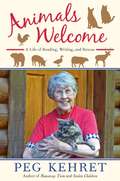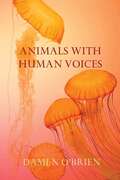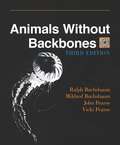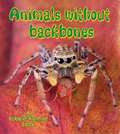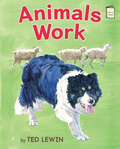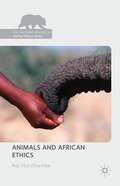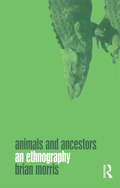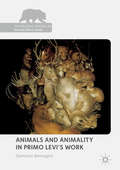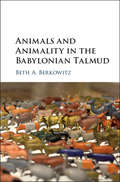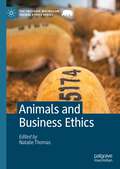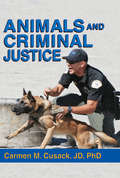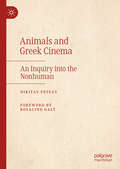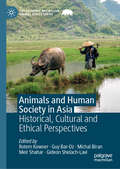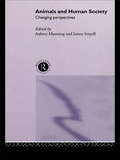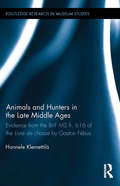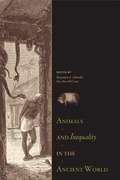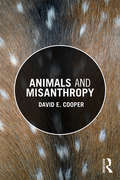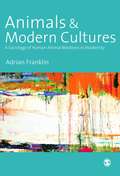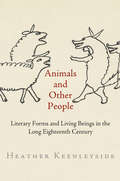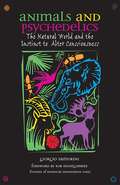- Table View
- List View
Animals Welcome: A Life of Reading, Writing, and Rescue
by Peg KehretA moving memoir from an award-winning authorA mother cat and her kittens, shot with a pellet gun. A poacher illegally stalking a bear. Peg Kehret tells these true stories and more as she invites readers into her life on a small wildlife sanctuary. Vividly showing the joys of animal rescue while providing facts about the animals and birds she encounters, Kehret also shares the tragedy of her husband's sudden death, and the pain of losing Pete, the shelter cat who co-authored three of her books. Written with honesty, heart, and humor, Animals Welcome is a personal glimpse into the life of an author who loves animals, and the philosophy by which she lives. .
Animals With Human Voices
by Damen O'BrienIn Animals with Human Voices you will find worms that dream of god, jellyfish weary of immortality, a powerless Superman, some illogical observations on aliens', a lightning conductor tired of lightning and the truth about Elvis. In multi award-winning poet Damen O'Brien's debut collection, his cinematic eye and love of nature deliver poems which are ciphers for the normal concerns of every human: love, life and death and what we leave behind.
Animals Without Backbones
by John Pearse Ralph Buchsbaum Mildred Buchsbaum Vicki PearseAnimals Without Backbones has been considered a classic among biology textbooks since it was first published to great acclaim in 1938. It was the first biology textbook ever reviewed by Time and was also featured with illustrations in Life. Harvard, Stanford, the University of Chicago, and more than eighty other colleges and universities adopted it for use in courses. Since then, its clear explanations and ample illustrations have continued to introduce hundreds of thousands of students and general readers around the world to jellyfishes, corals, flatworms, squids, starfishes, spiders, grasshoppers, and the other invertebrates that make up ninety-seven percent of the animal kingdom. This new edition has been completely rewritten and redesigned, but it retains the same clarity and careful scholarship that have earned this book its continuing readership for half a century. It is even more lavishly illustrated than earlier editions, incorporating many new drawings and photographs. Informative, concise legends that form an integral part of the text accompany the illustrations. The text has been updated to include findings from recent research. Eschewing pure morphology, the authors use each group of animals to introduce one or more biological principles. In recent decades, courses and texts on invertebrate zoology at many universities have been available only for advanced biology majors specializing in this area. The Third Edition of Animals Without Backbones remains an ideal introduction to invertebrates for lower-level biology majors, nonmajors, students in paleontology and other related fields, junior college and advanced high school students, and the general reader who pursues the rewarding study of the natural world.
Animals Without Backbones (Big Science Ideas)
by Bobbie KalmanDescribes the different kinds of invertebrates and how they function without backbones, including sponges, worms, squids, crustaceans, insects, and spiders.
Animals Without Backbones: An Introduction to the Invertebrates (New Plan Texts at the University of Chicago)
by John Pearse Ralph Buchsbaum Mildred Buchsbaum Mildredd BuchsbaumAnimals Without Backbones has been considered a classic among biology textbooks since it was first published to great acclaim in 1938. It was the first biology textbook ever reviewed by Time and was also featured with illustrations in Life. Harvard, Stanford, the University of Chicago, and more than eighty other colleges and universities adopted it for use in courses. Since then, its clear explanations and ample illustrations have continued to introduce hundreds of thousands of students and general readers around the world to jellyfishes, corals, flatworms, squids, starfishes, spiders, grasshoppers, and the other invertebrates that make up ninety-seven percent of the animal kingdom. This new edition has been completely rewritten and redesigned, but it retains the same clarity and careful scholarship that have earned this book its continuing readership for half a century. It is even more lavishly illustrated than earlier editions, incorporating many new drawings and photographs. Informative, concise legends that form an integral part of the text accompany the illustrations. The text has been updated to include findings from recent research. Eschewing pure morphology, the authors use each group of animals to introduce one or more biological principles. In recent decades, courses and texts on invertebrate zoology at many universities have been available only for advanced biology majors specializing in this area. The Third Edition of Animals Without Backbones remains an ideal introduction to invertebrates for lower-level biology majors, nonmajors, students in paleontology and other related fields, junior college and advanced high school students, and the general reader who pursues the rewarding study of the natural world.
Animals Without Backbones: Invertebrates
by Bridget AndersonIf you are asked to picture an animal, what comes to your mind first? A dog? A bird? Perhaps a zebra? Chances are you thought of a vertebrate, an animal with a backbone. But vertebrates, which include the animals we are most familiar with--mammals, birds, fish, reptiles, and amphibians--actually make up less than 5% of all animal species. All the rest of the animals alive today--more than 95%--are invertebrates, animals without backbones. Can you picture a spotted ladybug, spiny sea urchin, or slimy garden slug? ANIMALS WITHOUT BACKBONES: INVERTEBRATES explores the lives of the many fascinating creatures.
Animals Work (I Like to Read)
by Ted LewinAnimals herd, carry, pull, and even . . . keep us company! This nonfiction, easy-to-read picture book transports readers from an open field to a desert to a snowy tundra as animals of all kinds perform some very important work. The book ends with an endearing role reversal as a young boy gives milk to his cat, reminding readers that just as animals help people, people in turn can help animals. This book teaches readers about the variety of work animals and depicts the give-and-take of human/animal relationships. A map is included. Guided Reading Level C.
Animals and African Ethics
by Kai HorsthemkeAfrican ethics is primarily concerned with community and harmonious communal relationships. The claim is frequently made on behalf of African moral beliefs and customs that African society does not objectify and exploit nature and natural existents, unlike Western moral attitudes and practices. This book investigates whether this claim is correct by examining religious and philosophical thought, as well as traditional cultural practices in Africa. Through exploration of what kind of status is reserved for other-than-human animals in African ethics, Horsthemke argues that moral perceptions and attitudes on the African continent remain resolutely anthropocentric, or human-centred. Although values like ubuntu (humanness) and ukama (relationality) have been expanded to include nonhuman nature, animals have no rights, and human duties to them are almost exclusively 'indirect'. Animals and African Ethics concludes by asking whether those who, following their own liberation, continue to exploit and oppress other creatures, are not thereby contributing to their own dehumanization.
Animals and Ancestors: An Ethnography
by Brian MorrisEver since the emergence of human culture, people and animals have co-existed in close proximity. Humans have always recognized both their kinship with animals and their fundamental differences, as animals have always been a threat to humans' well-being. The relationship, therefore, has been complex, intimate, reciprocal, personal, and -- crucially -- ambivalent. It is hardly surprising that animals evoke strong emotions in humans, both positive and negative. This companion volume to Morris' important earlier work, The Power of Animals, is a sustained investigation of the Malawi people's sacramental attitude to animals, particularly the role that animals play in life-cycle rituals, their relationship to the divinity and to spirits of the dead. How people relate to and use animals speaks volumes about their culture and beliefs. This book overturns the ingrained prejudice within much ethnographic work, which has often dismissed the pivotal role animals play in culture, and shows that personhood, religion, and a wide range of rituals are informed by, and even dependent upon, human-animal relations.
Animals and Animality in Primo Levi’s Work (The Palgrave Macmillan Animal Ethics Series)
by Damiano BenvegnùSituated at the intersection of animal studies and literary theory, this book explores the remarkable and subtly pervasive web of animal imagery, metaphors, and concepts in the work of the Jewish-Italian writer, chemist, and Holocaust survivor Primo Levi (1919-1987). Relatively unexamined by scholars, the complex and extensive animal imagery Levi employed in his literary works offers new insights into the aesthetical and ethical function of testimony, as well as an original perspective on contemporary debates surrounding human-animal relationships and posthumanism. The three main sections that compose the book mirror Levi’s approach to non-human animals and animality: from an unquestionable bio-ethical origin (“Suffering”); through an investigation of the relationships between writing, technology, and animality (“Techne”); to a creative intellectual project in which literary animals both counterbalance the inevitable suffering of all creatures, and suggest a transformative image of interspecific community (“Creation”).
Animals and Animality in the Babylonian Talmud
by Beth A. BerkowitzAnimals and Animality in the Babylonian Talmud selects key themes in animal studies - animal intelligence, morality, sexuality, suffering, danger, personhood - and explores their development in the Babylonian Talmud.<P><P> Beth A. Berkowitz demonstrates that distinctive features of the Talmud - the new literary genre, the convergence of Jewish, Christian, and Zoroastrian cultures, the Talmud's remove from Temple-centered biblical Israel - led to unprecedented possibilities within Jewish culture for conceptualizing animals and animality. She explores their development in the Babylonian Talmud, showing how it is ripe for reading with a critical animal studies perspective. When we do, we find waiting for us a multi-layered, surprisingly self-aware discourse about animals as well as about the anthropocentrism that infuses human relationships with them. For readers of religion, Judaism, and animal studies, her book offers new perspectives on animals from the vantage point of the ancient rabbis.<P> Introduces animal studies to Jewish studies readers, showing them the important role played by animals within Judaism.<P> Offers coverage of a number of key areas within animal studies, giving readers an overview of major areas of interest in animal studies.<P> Highlights passages in the Babylonian Talmud that contribute surprising perspectives on animals, allowing readers of the Babylonian Talmud to see features in it that they never did before.
Animals and Business Ethics (The Palgrave Macmillan Animal Ethics Series)
by Natalie ThomasThis book engages with some of the most pressing ethical issues that arise from the use of animals in various business practices, providing interdisciplinary approaches to improving the nonhuman and human lives in animal-related industries. The chapters in this volume provide conceptual, theoretical and practical analyses of these issues that will shape the future direction of business ethics to more fully refl ect the impacts and implications of animal-based businesses on society, its members, and nature. The authors in this volume engage with topics including animal suffering and emotions, the commodifi cation of animals, vegetarian and vegan businesses and diets, technological innovations such as gene editing and lab-cultured meat, as well as captivity, corporate disclosure of animal welfare policies, and the possibility of humane jobs as well as the consideration of animals as stakeholders.
Animals and Criminal Justice
by Carmen M. CusackMahatma Gandhi said, "The greatness of a nation and its moral progress can be judged by the way its animals are treated." Since civil societies are ruled by law, they can be evaluated, both figuratively and literally, by how animals are treated in the criminal justice system. This book depicts animals' roles within society and the laws that govern how humans treat them. Carmen M. Cusack focuses on current issues in human-animal relationships and how these are affected by the criminal justice system. Her analysis, while objective, is rooted in first-hand activist, professional, legal, and criminal justice experience. She presents a comprehensive overview of the place of animals and the law, including pets in prison, K-9 units, constitutional rights, animal sacrifice, wild animals, entertainment, domestic violence, rehabilitation, history, and religion. She includes information about law, behavioural and social science, systemic responses and procedure, anecdotal evidence, current events, and theoretical considerations. Animals and Criminal Justice is a useful handbook and a thorough textbook, as well as a practical guide to animals' relationships with the criminal justice system. Professionals, including police, child protective services, judges, animal control officers, and corrections staff, as well as scholars in the fields of criminal justice and criminology will find this book invaluable.
Animals and Desire in South African Fiction: Biopolitics and the Resistance to Colonization (Palgrave Studies in Animals and Literature)
by Jason D. PriceThis book considers the political potential of affective experiences of desire as reflected in contemporary South African literature. Jason Price argues that definitions of desire deployed by capitalist and colonial culture maintain social inequality by managing relations to ensure a steady flow of capital and pleasure for the dominant classes, whereas affective encounters with animals reveal the nonhuman nature of desire, a biopower that, in its unpredictability, can frustrate regimes of management and control. Price wonders how animals' different desires might enable new modes of thought to positively transform and resist the status quo. This book contends that South African literary works employ nonhuman desire and certain indigenous notions of desire to imagine a South Africa that can be markedly different from the past.
Animals and Greek Cinema: An Inquiry into the Nonhuman
by Nikitas FessasThis book offers a non-anthropocentric account of a national cinema. Drawing on cutting-edge developments in Animal (film) studies, the book gathers a wide range of species and genres to discuss the Greek cinematic animal. This en-tails recalibrating the readers&’/viewers&’ gazes to include particular nonhumans, often displaced in the frame&’s margins. While acknowledging the cost paid in animal suffering for Greek cinema to rise, the book features instances of animal-human bonding. Combining close readings with interviews with directors, human actors, screenwriters, cinematographers, producers, special effects artists, and animal wranglers, this book proposes a paradigm of human-animal praxis, arguing that revisiting nonhuman images can lead to renewed ethical relations, and to less speciesist cinemas, film industries, and societies.
Animals and Human Society in Asia: Historical, Cultural and Ethical Perspectives (The Palgrave Macmillan Animal Ethics Series)
by Rotem Kowner Michal Biran Gideon Shelach-Lavi Meir Shahar Guy Bar-OzThis edited collection offers a comprehensive overview of the different aspects of human-animal interactions in Asia throughout history. With twelve thematically-arranged chapters, this book examines the diverse roles that beasts, livestock, and fish — real and metaphorical– have played in Asian history, society, and culture. Ranging from prehistory to the present day, the authors address a wealth of topics including the domestication of animals, dietary practices and sacrifice, hunting, the use of animals in war, and the representation of animals in literature and art. Providing a unique perspective on human interaction with the environment, the volume is cross-disciplinary in its reach, offering enriching insights to the fields of animal ethics, Asian studies, world history and more.
Animals and Human Society: Changing Perspectives
by James Serpell Aubrey ManningModern society is beginning to re-examine its whole relationship with animals and the natural world. Until recently issues such as animal welfare and environmental protection were considered the domain of small, idealistic minorities. Now, these issues attract vast numbers of articulate supporters who collectively exercise considerable political muscle. Animals, both wild and domestic, form the primary focus of concern in this often acrimonious debate. Yet why do animals evoke such strong and contradictory emotions in people - and do our western attitudes have anything in common with those of other societies and cultures? Bringing together a range of contributions from distinguished experts in the field, Animals and Society explores the importance of animals in society from social, historical and cross-cultural perspectives.
Animals and Hunters in the Late Middle Ages: Evidence from the BnF MS fr. 616 of the Livre de chasse by Gaston Fébus (Routledge Research in Museum Studies)
by Hannele KlemettiläThis book explores views of the natural world in the late Middle Ages, especially as expressed in Livre de chasse (Book of the Hunt), the most influential hunting book of the era. It shows that killing and maiming, suffering and the death of animals were not insignificant topics to late medieval men, but constituted a complex set of issues, and could provoke very contradictory thoughts and feelings that varied according social and cultural milieus and particular cases and circumstances.
Animals and Inequality in the Ancient World
by Sue Ann Mccarty Benjamin S. ArbuckleAnimals and Inequality in the Ancient World explores the current trends in the social archaeology of human-animal relationships, focusing on the ways in which animals are used to structure, create, support, and even deconstruct social inequalities. The authors provide a global range of case studies from both New and Old World archaeology--a royal Aztec dog burial, the monumental horse tombs of Central Asia, and the ceremonial macaw cages of ancient Mexico among them. They explore the complex relationships between people and animals in social, economic, political, and ritual contexts, incorporating animal remains from archaeological sites with artifacts, texts, and iconography to develop their interpretations.Animals and Inequality in the Ancient World presents new data and interpretations that reveal the role of animals, their products, and their symbolism in structuring social inequalities in the ancient world. The volume will be of interest to archaeologists, especially zooarchaeologists, and classical scholars of pre-modern civilizations and societies.
Animals and Inequality in the Ancient World
by Benjamin S. Arbuckle and Sue Ann McCartyAnimals and Inequality in the Ancient World explores the current trends in the social archaeology of human-animal relationships, focusing on the ways in which animals are used to structure, create, support, and even deconstruct social inequalities. The authors provide a global range of case studies from both New and Old World archaeology—a royal Aztec dog burial, the monumental horse tombs of Central Asia, and the ceremonial macaw cages of ancient Mexico among them. They explore the complex relationships between people and animals in social, economic, political, and ritual contexts, incorporating animal remains from archaeological sites with artifacts, texts, and iconography to develop their interpretations. Animals and Inequality in the Ancient World presents new data and interpretations that reveal the role of animals, their products, and their symbolism in structuring social inequalities in the ancient world. The volume will be of interest to archaeologists, especially zooarchaeologists, and classical scholars of pre-modern civilizations and societies.
Animals and Misanthropy
by David E. CooperThis engaging volume explores and defends the claim that misanthropy is a justified attitude towards humankind in the light of how human beings both compare with and treat animals. Reflection on differences between humans and animals helps to confirm the misanthropic verdict, while reflection on the moral and other failings manifest in our treatment of animals illuminates what is wrong with this treatment. Human failings, it is argued, are too entrenched to permit optimism about the future of animals, but ways are proposed in which individual people may accommodate to the truth of misanthropy through cultivating mindful, humble and compassionate relationships to animals. Drawing on both Eastern and Western philosophical traditions David E. Cooper offers an original and challenging approach to the complex field of animal ethics.
Animals and Modern Cultures: A Sociology of Human-Animal Relations in Modernity
by Adrian FranklinThe dramatic transformation of relationships between humans and animals in the 20th century are investigated in this fascinating and accessible book. At the beginning of this century these relationships were dominated by human needs and interests, modernization was a project which was attached to the goal of progress and animals were merely resources to be used on the path towards human fulfilment. These relationships are increasingly being subjected to criticism and a new field of interest in human-animal relationships has opened up. We are now urged to be more sensitive and compassionate to animal needs and interests, to understand their mindedness and how their lives and ours are entangled. This book focuses on social change and animals, it is concerned with how humans relate to animals and how this has changed and why. Moreover, it highlights, through chapters on companion animals, hunting and fishing, animal leisures such as birdwatching and wildlife parks, and the meat and livestock industries, how attitudes and practices towards animals vary widely according to social class, ethnicity, gender, region and nation.
Animals and Other People: Literary Forms and Living Beings in the Long Eighteenth Century
by Heather KeenleysideIn Animals and Other People, Heather Keenleyside argues for the central role of literary modes of knowledge in apprehending animal life. Keenleyside focuses on writers who populate their poetry, novels, and children's stories with conspicuously figurative animals, experiment with conventional genres like the beast fable, and write the "lives" of mice as well as men. From such writers—including James Thomson, Daniel Defoe, Jonathan Swift, Laurence Sterne, Anna Letitia Barbauld, and others—she recovers a key insight about the representation of living beings: when we think and write about animals, we are never in the territory of strictly literal description, relying solely on the evidence of our senses. Indeed, any description of animals involves personification of a sort, if we understand personification not as a rhetorical ornament but as a fundamental part of our descriptive and conceptual repertoire, essential for distinguishing living beings from things.Throughout the book, animals are characterized by a distinctive mode of agency and generality; they are at once moving and being moved, at once individual beings and generic or species figures (every cat is also "The Cat"). Animals thus become figures with which to think about key philosophical questions about the nature of human agency and of social and political community. They also come into view as potential participants in that community, as one sort of "people" among others. Demonstrating the centrality of animals to an eighteenth-century literary and philosophical tradition, Animals and Other People also argues for the importance of this tradition to current discussions of what life is and how we might live together.
Animals and Psychedelics: The Natural World and the Instinct to Alter Consciousness
by Giorgio Samorini Rob MontgomeryAn Italian ethnobotanist explores the remarkable propensity of wild animals to seek out and use psychoactive substances. • Throws out behaviorist theories that claim animals have no consciousness. • Offers a completely new understanding of the role psychedelics play in the development of consciousness in all species. • Reveals drug use to be a natural instinct. From caffeine-dependent goats to nectar addicted ants, the animal kingdom offers amazing examples of wild animals and insects seeking out and consuming the psychoactive substances in their environments. Author Giorgio Samorini explores this little-known phenomenon and suggests that, far from being confined to humans, the desire to experience altered states of consciousness is a natural drive shared by all living beings and that animals engage in these behaviors deliberately. Rejecting the Western cultural assumption that using drugs is a negative action or the result of an illness, Samorini opens our eyes to the possibility that beings who consume psychedelics--whether humans or animals--contribute to the evolution of their species by creating entirely new patterns of behavior that eventually will be adopted by other members of that species. The author's fascinating accounts of mushroom-loving reindeer, intoxicated birds, and drunken elephants ensure that readers will never view the animal world in quite the same way again.
Animals and Public Health
by Aysha AkhtarA compelling argument of how human health is adversely affected by our poor treatment of non-human animals. The author contents that in order to successfully confront the 21st Century's health challenges, we need to broaden the definition of the word 'public' in public health to include non-human animals.
